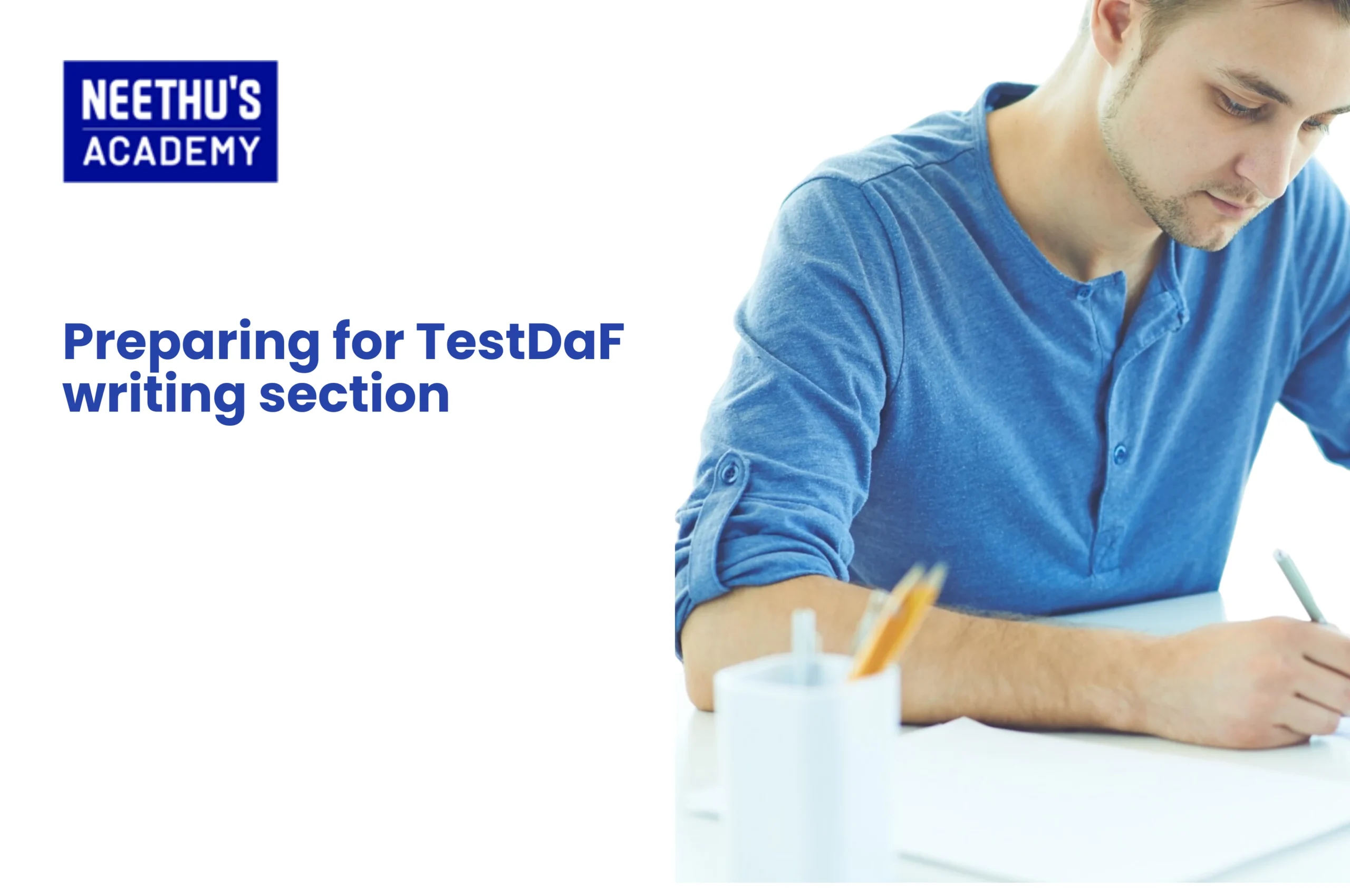Looking forward to your German Goethe examination? Then it’s only right if you learn about the scoring system. In today's globalized world,…

TestDaF Writing Preparation: Best Tips and Strategies to Boost Your Score
The TestDaF (Test Deutsch als Fremdsprache) is a German proficiency test that is accepted by most German universities. It is designed for students who want to study in Germany and working professionals who want to work there. The writing section of this examination is the toughest, as it not only checks your grammar but also examines your thinking skills, organization of thoughts, and how you express them logically in written German.
If you’re preparing your TestDaF writing, you’ve come to the right place. In this blog, we’ll discuss important TestDaF writing tips, exercises, and the most effective strategies to enhance your TestDaF writing abilities. Whether you’re studying independently or taking classes at a German language school, the following tips will assist you in gaining confidence and organization in your writing.
Understanding the TestDaF Writing Section
The written section of the TestDaF, also called Teil 4, tests how well you can write in an academic environment. You will be presented with an assignment that usually consists of:
- A chart, diagram, or table filled with data.
- A brief text or statement explaining a trend or subject.
- An assignment asking for your opinion about the topic being discussed.
You will be given 60 minutes to answer in a well-structured text of approximately 200–250 words. Your answer should contain:
- An effective introduction to the topic and image.
- An explanation and interpretation of the information.
- A well-organized opinion with reasons and illustrations.
- An effective conclusion summarizing your opinion.
This task simulates the kind of writing you find at a German university. As such, writing practice for the TestDaF needs to address more than merely basic grammar, but also requires coherence, style, and reasonableness of ideas.
Useful Strategies to Prepare for the TestDaF Writing Section
Strong groundwork and frequent practice hold the secrets of success when it comes to the preparation of the TestDaF writing section. Here are efficient strategies that help test-takers to do well:
1. Know the Format in Detail
Start by studying the exam format and scoring criteria of the writing section. Learn how your text is being evaluated by the examiners for content relevance, structure, vocabulary, and grammar.
2. Practice with Official TestDaF Practice Tests
Integrate TestDaF practice tests into your study schedule. These materials enable you to become accustomed to the exam format, handle time more effectively, and recognize frequent patterns of prompts.
3. Focus on Transitional Words and Logical Connectors
To create flow between sentences and paragraphs, master the use of connectors like:
Zunächst, darüber hinaus, hingegen, zum Beispiel, abschließend
These not only make your text more readable but also show examiners that you’re capable of academic writing in German.
4. Practice with Real Graphs and Tables
Go to sites such as Statista or Eurostat and look for actual statistical information. Write brief essays explaining trends, comparing, and giving opinions. This is great TestDaF writing practice that simulates real exam assignments.
5. Plan Before You Write
Take the first 5–10 minutes to make a rough outline of your essay. List your introduction idea, 2–3 main points with supporting arguments, and a conclusion. This avoids confusion and organizes thoughts logically.
6. Review and Edit
Never skip proofreading your work. Set aside at least 5 minutes to scan your writing. Check for grammatical errors, sentence structure, or repetition of vocabulary. This minor process can enhance TestDaF scores in writing.
Common Mistakes to Avoid
These are common mistakes that test takers commit while responding to the writing section, and how to stay clear of them:
- Not addressing the chart: Your answer should specifically refer to the visual information. Don’t provide a general opinion essay.
- Weak thesis statements: Your opinions must be precisely stated in the introduction.
- Repeated words: Enrich your writing using synonyms and varied sentence styles.
- Too many disorganized sentences: Organize your writing into 3–5 paragraphs to give your essay cohesion.
- Failure to write formally: The academic writing should not involve slang, contractions, or little to no informal usage.
Sample Practice Topics and Exercises
Practicing with sample topics is a great way to reinforce your TestDaF preparation methods. Below are some topics to help you begin:
A table shows the rising rent price in major German cities. Describe the trend and provide your opinion on whether rent control legislation is needed.
A graph shows growth in online learning among German university students. Analyze the trend and comment on its long-term effects.
A bar chart is used to contrast car use against public transport use over a 10-year timeline. Comment on the trends and give your own view on transport policy in the future.
Tips for Writing Exercise:
- Set yourself exactly 60 minutes.
- Stay within the word limit (200–250 words).
- Emphasize connectors and review your verb positions.
- Compare your answer with a sample answer if available.
Best German Language Institute in Kerala
Enrolling for a German language course provides specialized instruction, particularly to those who need to enhance their German at the academic level. Neethu’s Academy, one of the well-known German language colleges in Kerala, provides you with complete TestDaF coaching so that students can concentrate on writing skills, test strategy, and self-correction.
Conclusion
The TestDaF writing section is an important part of the test that requires planning, coherent writing, and academic vocabulary. With the appropriate blend of TestDaF writing tips, consistent practice, and professional feedback, you can approach this section confidently and concisely.
Whether you’re learning on your own or attending a German language course, remember that improvement comes from deliberate, focused writing efforts. Use TestDaF practice tests, study sample responses, and don’t hesitate to seek help from qualified instructors. With the right mindset and resources, you’ll be well on your way to mastering the writing section of the TestDaF.
Frequently Asked Questions
It is fairly difficult, especially if you haven’t spoken and written using academic German previously.
Yes, it is enough, although the C1 level is recommended for higher pass rates.
TestDaF is slightly tougher due to academic emphasis and the requirements of the university level.
Both are well reputed, but TestDaF is a better fit for German university admissions.
Related Blogs
- All Posts
- German
Learning a new language can be exciting and challenging. For those starting their journey with German, the A1 Goethe German Exam is…
Speaking in front of someone may not be everyone’s cup of tea. But when it is a mandatory criterion to attain your…
Course Enquiry
Latest Posts
- All Posts
- canada
- CBT
- DHA
- French
- GENERAL
- German
- Haad
- IELTS
- IQN NEW ZEALAND
- MOH
- NCLEX-RN
- NHRA
- OET
- OSCE
- Pearson Vue
- PROMETRIC
- PTE
- TOEFL
- Back
- NCLEX - NGN
- Back
- OET FOR PHYSIOTHERAPIST
- OET FOR PHARMACIST
- OET FOR DOCTORS



